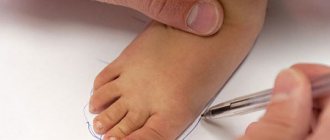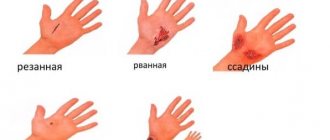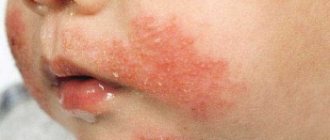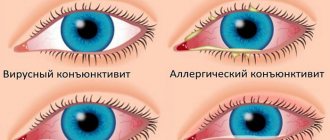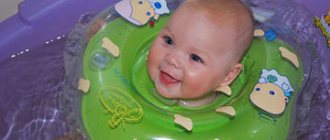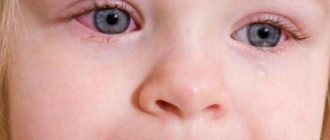In babies, sometimes the skin begins to peel off, redness and small bursting blisters appear on it. Particularly unpleasant is the itching, which causes previously calm infants to become capricious and refuse to eat. This is how diathesis manifests itself, causing inconvenience to children and making their parents suffer.
Despite the extremely unpleasant symptoms, pediatricians do not classify the pathological process as a disease, but consider it an individual feature of the child’s body. Diathesis in infants should be treated immediately, otherwise it will become chronic and cause allergic reactions and atopic dermatitis.
How to cure diathesis with folk remedies
Not only medications, but also folk remedies are effective in the fight against diathesis. It is recommended to give the child a medicinal decoction of vegetables and herbs. To do this, mix cabbage, dill and parsley in equal proportions.
The mixture is filled with a small amount of water.
It should be boiled for ten minutes and then strained.
The baby should be given the cooled solution in small portions twice a day. The course of treatment is five days.
You can prepare a medicinal ointment yourself. You need to mix four teaspoons of baby cream and two teaspoons of fir oil. The prepared product is applied to damaged areas three times a day.
A remedy made from sea buckthorn oil and brilliant green will help cope with diathesis. Add 30 drops of brilliant green to a bottle of oil (50 ml). The components must be mixed, the bottle is shaken.
After this, the medicine can be applied to problem areas three times a day.
Bay leaves help the child recover. You need to boil ten large leaves in a liter of water. Cooking time should not exceed five minutes.
Before removing the solution from the stove, it is recommended to add one tablespoon of rose hips to the mixture. The composition is infused overnight and filtered in the morning.
It should be taken half a glass twice a day.
Calendula tincture will help your baby's skin recover. To do this, combine 25 g of raw materials and one glass of boiling water. The solution needs to steep for one and a half to two hours. After this, the infusion is cooled and filtered.
During the day you need to make lotions from this product several times. It eliminates itching, burning, and helps eliminate redness. When the baby becomes healthy very soon, the child will stop feeling pain and being capricious.
Diathesis in children is a serious disease that causes pain and discomfort. If the diathesis is not treated, the redness will increase. It will lead to skin irritation and the baby’s whims.
Complex treatment will restore health and eliminate unpleasant symptoms and sensations. Before using medications, it is recommended to consult a doctor.
At home, you can very effectively treat your baby, eliminate swelling, red spots and burning. The parents’ task is to cure the baby and review his diet.
Perhaps the source of the problem is a certain product that is perceived by the child’s body as an allergen. A responsible approach to treatment will allow you to quickly get rid of diathesis.
Operating principle
To get rid of diathesis, you need to detect the allergen that provoked such a reaction. After eliminating the allergen, the skin will heal faster - itchy, flaky spots will disappear. To eliminate them, hormonal and non-hormonal drugs are prescribed.
Hormonal ones contain synthetic analogues of corticosteroid hormones, hydrocortisone. They exhibit anti-inflammatory effects and can reduce collagen synthesis in skin structures. Eliminate itching and swelling of the affected areas.
Non-hormonal ointments and creams for diathesis on the cheeks in children are based on zinc oxide, plant extracts of chamomile, calendula, and dexpanthenol. Zinc ointments have an antiseptic and astringent effect, absorb excess fluids and soften the skin.
Plant extracts are aimed at moisturizing and reducing inflammation. Dexpanthenol is converted into pantothenic acid and acts like a vitamin.
Treatment of diathesis in children
Proper nutrition
Treatment of this disease in children under one year of age should begin immediately after the first symptoms appear. First of all, you should completely change your diet. So, it is necessary to remove juices (tomato, citrus, carrot), which most often cause allergic reactions, from the children's diet. Next, cross off from the list products that contain a high concentration of essential oils and plant proteins, as they can cause diarrhea, skin rashes and hives.
Speaking of vegetables and fruits, they are very important for a child’s diet because they contain a lot of vitamins and minerals. However, if your child has symptoms of diathesis, you should make sure that plant products are used only in thick foods, and even then in small doses.
The key to successful treatment of diathesis will be the exclusion from baby food of foods containing trophallergens - spices, meat, chocolate, poultry and river fish. In addition, you should reduce your consumption of milk and eggs.
Additionally, it is necessary to monitor the nutrition of nursing mothers, since the food they take can also cause a variety of allergic reactions. Remember that your child's health directly depends on your diet.
Traditional methods of treating diathesis
If diathesis in a child is diagnosed in a timely manner, then the process of treatment and recovery will proceed quite quickly and easily. And treating this disease is very simple! To do this, you need to follow a few basic rules:
It is worth excluding from the children's diet those foods that can cause allergic reactions. Remember that treatment will only be successful if you adhere to a special children's diet; Care for bed linen, dishes and other children's accessories should be carried out using a hypoallergenic detergent
In addition, you can add soda to the water; It is important to observe the rules of personal hygiene, which include frequent swaddling and changing of the child; Direct contact with synthetic objects should be minimized.
Moreover, it is worth remembering such therapeutic elements as hardening, massage and physiotherapy. They will help strengthen your child's immunity. And this, in turn, will have a positive effect on his general health.
And finally, if your child’s diathesis has reached an advanced stage, contact a specialist. Remember that only an experienced doctor can make an accurate diagnosis and prescribe the correct treatment.
Traditional medicine against childhood diathesis
Very often, folk remedies are used in the treatment of diathesis. One of the most effective folk methods is herbal baths, which disinfect, tone and soothe the child’s skin. However, before starting this type of treatment, it is worth remembering to maintain the correct temperature regime. Thus, the water temperature should not exceed 36-38°C, and the duration of stay in the water should not exceed 15-20 minutes. We recommend that you familiarize yourself with our recommendations for bathing your child.
There are several effective recipes for herbal decoctions for baths. Oak bark decoction. For it you will need:
- 1 kg crushed oak bark
- 1 liter of water.
Cooking procedure
Pour the crushed bark with water and place on low heat. Boil for 30 minutes. After the decoction has cooled, strain and pour into the bath where the child will bathe. Decoction of walnut leaves To prepare this decoction you need to take 3 leaves (green or dry) of walnut. Pour them with 1 liter of water and boil for 45 minutes. After the decoction is ready, strain and add to water in the appropriate proportion:
- 1 liter of decoction for a full bath
- 500 ml – for a half-filled bath
A decoction of chamomile flowers. For this you will need:
- 250 g dry chamomile (inflorescences)
- 1 liter of water
Pour 250 grams of chamomile into 1 liter of cold water. Boil for 10 minutes. Next, strain the broth and add to water.
Remember – your child’s health is in your hands!
https://www.youtube.com/watch?v=M2fd6ri5YAI
What to apply: recommended creams and products
Depending on the place of application, you need to choose the appropriate treatment. Experts have developed medications that are aimed at combating diathesis in a specific part of the body.
On the face and cheeks
Elidel cream is recommended for use for diathesis on the face and cheeks. It fights redness and helps relieve itching. The product can be used from three months of age. Apply the cream 2-3 times a day.
Guzhienko's paste is effective in the treatment of diathesis. It is used from the age of six months. The product is applied in a thin layer to the baby’s skin twice a day.
With regular use, the redness will disappear quite quickly: within one to two weeks.
It is allowed to use Advant cream from the age of four months. It eliminates diathesis in the shortest possible time and prevents it from reappearing. Apply the cream only once a day.
On the butt
Experts advise treating the baby with Desitin cream.
It combats red spots, itching and burning.
Diathesis on the butt disappears after a few days of using the medicine. You need to use it twice a day.
The drug Fenistil is recommended by experts. It contains effective components that quickly eliminate diathesis. The ointment is applied to the child’s bottom twice a day in a thin layer.
Triderm ointment can be used if the baby is over one year old. The product prevents diathesis from progressing and relieves itching and burning.
With this drug, the redness disappears within a few days. The medicine should be used once or twice a day.
On arms and legs
If redness appears on the baby's hands and feet, Diathesis of the feet ointment should be used. It is suitable for children over four months. Apply to skin 2-3 times a day.
It is recommended to cleanse the skin before use
The ointment does not cause pain, burning, acts very carefully
Diprosalik is recommended for severe diathesis, when redness has occupied a large area on the baby’s body. The product is recommended to be used only after reaching the age of one year.
The drug is applied in a thin layer to the damaged area twice a day. If the child’s diathesis progresses, it is allowed to increase the number of procedures to three per day.
Did you know that diathesis also occurs in adults? Symptoms may vary depending on the person's age.
Review of drugs
In the treatment of infants, non-hormonal creams and ointments for diathesis based on natural ingredients and inorganic substances are used. The use of hormonal drugs is allowed only under the supervision of a doctor and after a year.
Ointments and creams for diathesis for children under one year old
Photo from farmlend.ru
In the treatment of diathesis in children under one year old, the following ointments and creams are used:
- Diaderm consists of natural ingredients: sage oil, larch resin, clary sage, sea buckthorn oil, allantoin, vitamins C, E and A, peppermint oil. Disinfects the wound, enhances skin regeneration, softens dry crusts.
- Desitin is an ointment based on zinc oxide, which is often prescribed for diathesis in infants. Reduces skin irritation and inflammation, forms a thin film that prevents infection from spreading to the affected areas. Has a moderate astringent effect.
- Glutamol – cream with tea tree oil, zinc salt, glutamol, sorbitol and vitamins. Treats dermatitis, diathesis, inflammatory skin diseases in infants. It is also used to prevent the formation of dry crusts.
- Bepanten is a drug based on dexpanthenol. In skin cells it is converted into pantothenic acid and plays an important role in the metabolism of skin cells. Accelerates the recovery and regeneration of damaged skin.
- Zinc ointment is one of the best remedies for treating childhood diathesis in infants. Adsorbs moisture, exhibits antiseptic properties, reduces discharge from affected areas and softens dry skin. Relieves manifestations of inflammatory processes.
Ointments and creams for diathesis for children over one year old
Photo from the site o-krohe.ru
At this age, for chronic or prolonged inflammation, the following ointments and creams for diathesis are allowed:
- Lokoid is an ointment based on a synthetic derivative of hydrocortisone. Quickly relieves inflammation, itching, swelling. Recommended for non-infected skin lesions.
- Dermovate is a cream with clobetasol propionate, a synthetic analogue of corticosteroids. It has a pronounced anti-inflammatory effect; minimal dosages are required to treat diathesis on the cheeks in children over one year of age. Apply a thin layer only to affected areas, small areas of skin.
- Elokom is an effective hormonal drug, but its use is best discussed with your doctor. The active ingredient is mometasone furoate, a representative of synthetic corticosteroids. For children from one to two years of age, the remedy for diathesis is used strictly under the supervision of a doctor and in small dosages.
- Advantan is a cream with methylprednisolone. Inhibits allergic and inflammatory reactions on the skin, therefore it is effective for diathesis. Eliminates pain, itching, burning, prevents infection. Since the drug is hormonal, it cannot be used on an ongoing basis.
- Fenistil is a non-hormonal drug. Represents antihistamines - they are intended specifically for the treatment of allergic manifestations. Helps with itching, irritation, anesthetizes the application site and cools it a little.
Among hormonal medications for diathesis, children are also prescribed Afloderm, Celestoderm-B, Beloderm, which are identical in their properties to synthetic analogues of prednisolone.
Treatment
Photo of what diathesis looks like on a child’s cheeks
Parents are interested in how to treat diathesis on the child’s cheeks. The most correct treatment is a complex effect. Its essence is to exclude all potential allergens and act directly on the skin itself.
What to apply to the cheeks will be determined by the attending physician based on tests and examination. The choice of drugs directly depends on the nature of the diathesis and the causes of rashes on the cheeks.
How to treat diathesis? Pay attention to the nuances of the course of the disease
- If there are weeping wounds on the cheeks, then antiseptic drugs are used. They can dry the skin and stimulate healing. The simplest and safest are furatsilin solution or fucorcin.
- If there are dry, scaly wounds on the baby's cheeks, hormonal ointments will be required to prevent the skin from drying out.
- It is not uncommon for infections to penetrate through the resulting wounds as a result of scratching. To protect your child from them, you will need to apply an antibacterial drug or prescribe the appropriate medication.
The types of ointments prescribed for diathesis depend on the age of your baby. For each age, there are certain safest and most effective ointments.
Newborns
If a child has just been born, but has already encountered diathesis, strong ointments cannot be used. Diathesis at this age has a predominantly mild stage. Therefore, children are prescribed non-hormonal drugs:
- Bepanten. Relieves itching and irritation, promotes healing. Apply no more than 5 times a day to the baby’s skin;
- Tsindol. The basis of the drug is zinc, which promotes recovery from weeping diathesis. Before applying the ointment, the baby's skin should be cleansed;
- Diaderm. Another zinc ointment that effectively relieves inflammation and has an antiseptic and healing effect.
Infants
If a baby suffers from diathesis, it is also better to do without hormonal ointments. There are several most popular drugs that will help a child cope with diathesis.
- Elidel. It has a non-hormonal basis. It fights well against irritation, itching and inflammation, preventing the skin from drying out. You can use the ointment no more than 1 time per day.
- Advantan. An excellent drug against dryness, irritation and itching. Also apply no more than once a day.
- Desitin. The basis of the ointment is zinc, which promotes healing and eliminates discomfort. The course should last up to 2 weeks. You are allowed to apply the ointment 2-3 times a day.
After a year
If by this time the symptoms of diathesis have not subsided, then you can resort to using an ointment that contains a small amount of hormones.
- Lackri. There are no specific hormones in it, but the herbs used in the preparation are not recommended for use by younger children. Copes well with rashes and irritations;
- Elokom. An ointment with a hormonal composition, which is characterized by an effective antimicrobial effect. You should not apply more than once a day. The course of treatment is limited to 2 weeks;
- Uniderm. Antiseptic ointment, which should be applied once a day. If the child is under 2 years old, the course of treatment with ointment lasts up to 5 days.
Simply anointing diathesis is not enough. Don't forget that the main reason lies in allergens. By excluding them from your baby’s life, you can count on your child’s speedy recovery.
General rules of application
Non-hormonal preparations should be applied to previously cleansed skin several times a day in a thin layer until the symptoms of diathesis in the child go away. Hormonal ointments and creams require very careful use. If you exceed the dosage, there is a risk of disrupting the functioning of the adrenal cortex.
Rules of application:
- apply in small quantities;
- if the condition improves, reduce the number of applications to 1 per day;
- To speed up the effect, you need to rub it in carefully so as not to damage the inflamed areas.
It is necessary to take precautions when treating hormonal ointments for diathesis in children. Do not use them on large areas of skin, in folds, with bandages or compresses. This leads to inhibition of the adrenal cortex; the reaction develops especially quickly in children.
If long-term treatment is needed, it is advisable to monitor the child's height and weight, as well as blood cortisol levels. If possible, treatment with corticosteroids is continued for no more than 5 days and is prescribed only when treatment with non-hormonal creams and ointments has not shown results.
What ointments help with diathesis in children over one year old?
Diathesis is a hereditary predisposition to the occurrence of certain pathological reactions and diseases. Most often it manifests itself in childhood.
Its main symptoms include redness of the cheeks, peeling of the epidermis, and dermatitis. To prevent or reduce the severity of diathesis, it is necessary to follow a diet.
A nursing mother needs to completely exclude the following types of food from her diet:
- chocolate;
- citrus;
- honey;
- nuts;
- red caviar;
- mushrooms;
- cow's milk;
- bakery products;
- smoked meats
You should also limit your consumption of chicken and beef. All red vegetables and fruits should be prohibited. Typically, from the age of six months, many parents begin to introduce complementary foods. At this time, the development of diathesis is also possible.
Infants with a hereditary predisposition to diathesis should not be given the following foods:
- eggs;
- seafood;
- herbal decoctions;
- red and orange vegetables and fruits;
- some cereals.
In most cases, the diet helps to completely get rid of the manifestations of diathesis, and with the right approach, children successfully “outgrow” this reaction.
Such drugs include:
- Elokom, which relieves intense itching and rashes.
- Advant, which relieves allergies and helps improve the condition (for children from one year old).
- Celestoderm, thanks to which the skin condition is stabilized and inflammatory processes are relieved.
- Smecta, which relieves abdominal pain and other inflammatory processes.
Such ointments are safe for a child if you follow moderation and do not use them unless prescribed by a specialist. Ointments are intended for children from one year old, so those who are younger should not use them, as this can negatively affect their health and cause an exacerbation of an allergic reaction.
loading…
As soon as you notice the appearance of symptoms in your baby such as redness of the skin (especially in the area of the cheeks, butt, groin folds), dryness, characteristic weeping rashes, itching, and so on, you need to contact a pediatrician, allergist or dermatologist. Depending on the nature of the manifestations, the specialist will be able to select the appropriate ointment or cream for diathesis for infants and older children.
What drugs are most in demand to treat such reactions in the body? All of them are divided into two groups:
- corticosteroid drugs;
- non-hormonal agents.
Diathesis is not an independent disease. You will not find such a diagnosis in any medical reference book. Diathesis is a predisposition to allergic reactions, which is usually inherited from parents. However, this pathology is accompanied by symptoms that are quite unpleasant for the child, for example, itchy skin rashes. To relieve your baby of discomfort, you can use special ointments, which will be discussed in this article.
- How to smear a child’s cheeks with diathesis
- How to tell if your child is cutting a tooth
- How to remove cheeks in Photoshop
For children over 1 year of age, infant formula and stronger hormonal medications can be used.
The most common of them:
- Elokom;
- Advantan;
- Prednisolone;
- Hydrocorticozone ointment;
- Lokoid.
Useful video about allergy medications
List of sources:
- Shabalov N.P. Diathesis and constitutional anomalies as a pediatric problem / Pediatrics. – 2005. – No. 5.
- Vasilevsky I.V. Optimization of skin care in newborns and infants / Clinical practice and health. – 2015. – No. 1.
- Toropova N.P., Sorokina K.N. Atopic dermatitis in children and adolescents - the evolution of views on pathogenesis and approaches to therapy / Russian Journal of Skin and Venereal Diseases. – 2014. – No. 6.
Daily care rules
Children suffering from diathesis require especially careful attention from parents and pediatricians. And not only during the period of exacerbation of the disease, but also during remission.
The skin needs to be protected from environmental influences, the cheeks and other problem areas should be moisturized with cream. Moreover, before starting treatment of the affected areas of the skin, it is necessary to determine what the cause of diathesis or allergies was, and to review the baby’s diet and bathing products. You must strictly follow your doctor’s recommendations about how long to use the prescribed ointment.
For daily care, moisturizing with a cream such as Bioderma or Topicrem is ideal. They are applied to the child’s skin twice a day. If parents believe that more frequent application is required, it is better to consult a pediatrician.
And remember that the most important thing in treating any child’s illness is mutual understanding between parents and pediatrician.
Contraindications and side effects
The drugs have their contraindications and side effects, in which their use would be critically contraindicated.
Experts say that such funds should be abandoned in the following cases:
- If you are concerned about an allergic reaction to the drugs themselves (this happens rarely).
- If the unpleasant symptoms, on the contrary, intensify and develop an allergic reaction, they also provoke itching, nausea, burning and redness of the skin.
- If the child’s immunity has not been properly developed, then it is prohibited to use the drugs independently without the advice of specialists.
- If the drugs are not suitable for the child’s age, then you should refuse them and not prescribe the dose yourself.
If you use them without the prescription and recommendations of doctors, you can provoke the further development of allergies, unpleasant symptoms and even complications that can become chronic and develop into other diseases. It is also prohibited to give children more than a certain amount of antibiotics, as this can disrupt the functioning of the organs of the gastrointestinal tract and cause severe nausea and vomiting in the process.
Diathesis can be cured using various means, but the most effective are creams and ointments, which experts recommend to each individual. They are useful for children because they are applied to the surface of the skin, and this helps improve the metabolic process, relieve inflammation and improve the condition of diathesis.
Treatment with folk remedies
Every mother, during periods of illness, asks the question - how to get rid of diathesis at home? The main folk recipes include the following:
- Treatment with eggshells.
The eggs are hard boiled. Clean them from the shell. Then the shell is boiled again for a few minutes and left to dry. The shells are dried in a cool place, laid out on a clean piece of paper or a towel. The inner film is removed. Next, the shells are crushed and added to lemon juice. Children under one year of age are given only the powder on the tip of a teaspoon once a day for three months. From one to two years, 6 drops of juice. For children over two years old, the dose of juice is doubled.
- Treatment with water.
Three liters of hot, boiled water are infused on the shells of twenty brown eggs for 24 hours. The child drinks this water. All food is prepared on it. You can also bathe your child in this water.
- Wiping the reddened areas with a solution of brilliant green with sea buckthorn oil. Add 30 drops of sea buckthorn oil to a jar of brilliant green.
- Bathing in a bath with a solution of potassium permanganate. For a liter of water, brew one glass of string, one glass of chamomile and several crystals of potassium permanganate. Add the decoction to the bath.
- Treatment with bay leaf decoction. 10 bay leaves are brewed with a liter of boiling water. The resulting mixture is boiled for 3 minutes over low heat. At the end of cooking, add one teaspoon of chopped rose hips. Infuse for twelve hours and filter. Take a tablespoon in the morning, at lunch and at night. You can add a spoon to tea. Take for six months.
Love your children. Your care will help them cope with any difficulties!
Video on the topic of the article:
https://youtube.com/watch?v=zoFidbTvU4A




